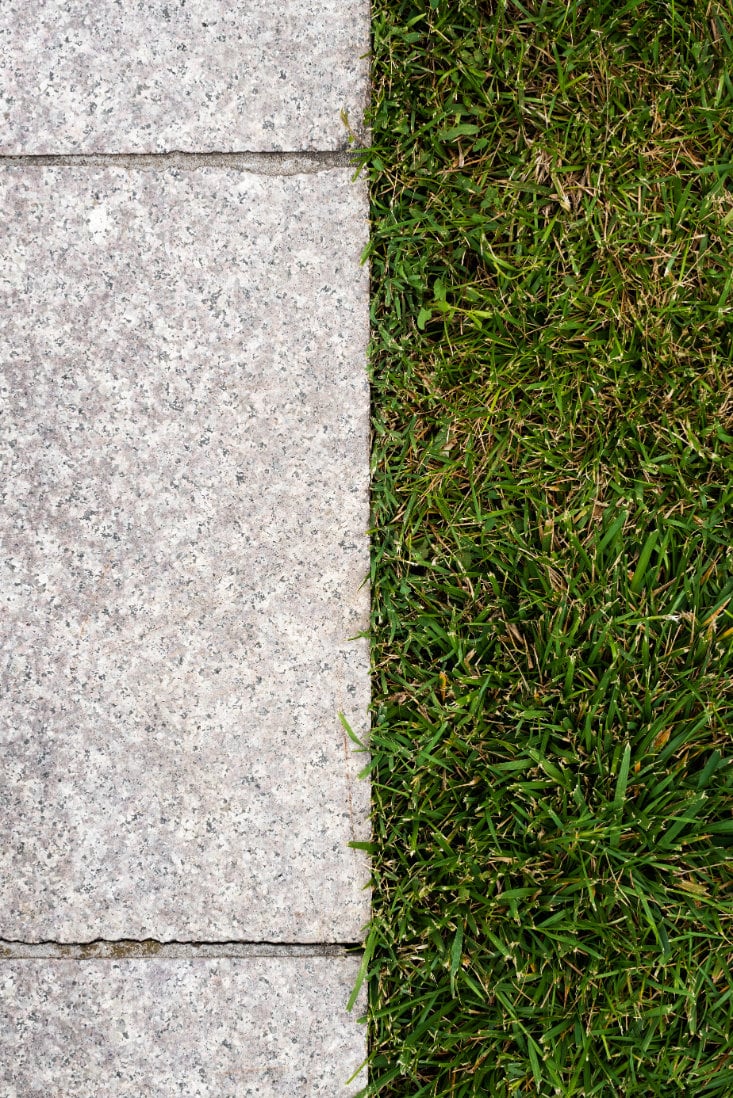While a lawn edged traditionally with edging shears a half moon edger is a thing of beauty, it can be labour intensive. So looking at a more permanent solution, what’s the best way to edge a lawn? Using a proper lawn edging material not only saves you heaps of time and faff, but it can be a beautiful and practical design feature in itself. Here we look at the ups and downs of metal, plastic, stone, and brick lawn edging.
What’s the best way to edge a lawn? Metal Edging
Positives: Metal edging, typically made of aluminium or steel, offers a sleek and modern look to the lawn. It provides a crisp, defined edge that effectively separates the grass from flower beds or pathways. Metal edging is durable, long-lasting, and resistant to weather conditions.
Negatives: Installation can be labour-intensive, requiring digging and careful placement. Metal edging may rust over time, especially in regions with high moisture levels, leading to maintenance concerns. It can also be a hazard if not properly secured, posing a risk of injury.
What’s the best way to edge a lawn? Plastic Edging
Positives: Plastic edging is cost-effective, lightweight, and easy to install, making it a popular choice for homeowners. It is available in various colours and styles, allowing for customization to match the garden’s aesthetics. Plastic edging is also flexible, allowing for curves and intricate designs.
Negatives: While economical, plastic edging is less durable than metal or stone options and may degrade over time due to exposure to sunlight and extreme temperatures. It might not provide a long-term solution for heavy traffic areas.
What’s the best way to edge a lawn? Natural Stone Edging
Positives: Stone edging, such as limestone or granite, adds a timeless and elegant touch to the landscape. It seamlessly blends with the natural environment and offers excellent durability, resisting weathering and erosion. Stone edging enhances the garden’s aesthetics and can withstand heavy traffic.
Negatives: Stone edging can be expensive and labour-intensive to install due to its weight and the need for precise placement. It might also shift over time, requiring occasional adjustments. Additionally, sourcing uniform stones for a consistent look can be challenging.
What’s the best way to edge a lawn? Brick Edging
Positives: Brick edging provides a classic and warm appearance to the lawn. It is relatively easy to install and can create both straight lines and intricate patterns. Bricks are durable and resistant to weather, offering long-lasting appeal.
Negatives: While sturdy, bricks can shift or become uneven over time, requiring maintenance. Ensuring proper alignment during installation is crucial to prevent issues. Additionally, brick edging might not be as versatile for creating smooth curves as some other materials.
In summary, the choice of lawn edging method depends on factors such as budget, aesthetics, durability, and ease of installation. Each option has its positives and negatives, requiring homeowners to carefully consider their specific needs and preferences when selecting the most suitable edging solution for their lawn.
Image by freepik.com
Owen Hayman
Owen joined the Bestall & Co planting and aftercare team in spring 2019. He is an RHS qualified horticulturist, holding a full Level 3 Diploma in Horticulture, and recently came in the top 3 at the Northern Regional Final of The Young Horticulturist of the Year 2019. After first doing a foundation diploma in Fine Art, he went on to gain a degree and masters in Plant and Soil Science from the University of Sheffield in 2014. Owen worked as a researcher on various field research projects in Alaska, Panama and Borneo. When not away in the field, he became obsessed with visiting gardens and nurseries across the British Isles and the Netherlands, developing his own garden, and then taking on a walled allotment garden as a personal project. He realised his true passion was in horticulture, and so moved away from academia and into the world of specialist plant nurseries and professional gardening.
Owen is now studying the Wisley Diploma, but continues to write articles for us on a monthly basis, and we're delighted to maintain contact with such a passionate and knowledgable plantsman.



